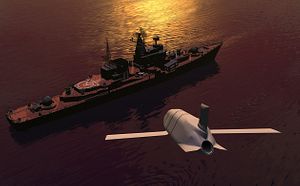The U.S. Navy and U.S. defense contractor Lockheed Martin conducted the first free flight launch of the Long-Range Anti-Ship Missile (LRASM), the U.S. military’s next-generation anti-ship missile with standoff capabilities. The launch was initiated from a B-1B Lancer strategic bomber over Point Mugu Sea Range in California on August 16.
The test constitutes the first end-to-end functionality test of the new weapon system. It confirmed the LRASMs ability to identity and prosecute a moving target at sea. “The missile navigated through all planned waypoints, transitioned to mid-course guidance and flew toward the moving maritime target using inputs from the onboard multimodal sensor,” according to a U.S. Navy statement. “It then descended to low altitude for final approach to target area, positively identified and impacted the target from among a group of ships.”
The LRASM began as a joint research project by the Defense Advanced Research Projects Agency (DARPA) and the U.S. Navy in 2009. The aim of the LRASM project was to deliver a new generation of anti-ship missiles with standoff capabilities — in other words, missiles with extended range, which would enable ships and aircraft to launch the weapon without being exposed to enemy counter fire. According to Lockheed Martin, the subsonic LRASM has an estimated range of over 320 kilometers and is fitted with a 450-kilogram penetrator and blast fragmentation warhead.
“Today marks a significant step towards providing the operational community with a leap in critical surface warfare capability by next year,” said Captain Todd Huber, the LRASM director, on August 16. In July, Lockheed Martin was awarded a contract for the production of 23 air-launched LRASM, officially designated AGM-158C. The LRASM is slated to be integrated on the B-1B Lancer heavy strategic bomber and the F/A-18E/F Super Hornet by the end of 2018 and 2019 respectively. The LRASM is an integral part of the U.S. Navy’s ‘Distributed Lethality’ concept of operations, I explained previously:
[A]s the U.S. Navy surface fleet is slowly implementing this new warfighting concept it still lacks a long-range, anti-surface missile (See: “The US Navy’s New Surface Warfare Strategy: ‘Distributed Lethality’”). The LRASM is slated to complement two other anti-ship missiles, the RGM-84D Harpoon Block 1C and the fifth-generation over-the-horizon Kongsberg Naval Strike Missile (NSM).
In late July, Lockheed Martin successfully conducted its first test firing of a surface-launched variant of the LRASM from a topside canister, positioned at the same angle and using the same launch controls as the vertical launch system used aboard U.S. Navy surface warships.

































